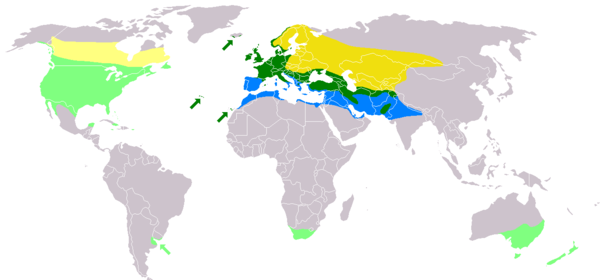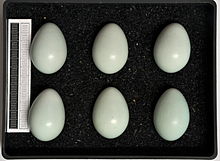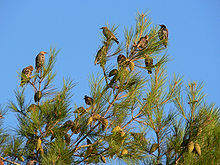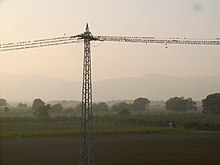Star (kind)
| star | ||||||||||||
|---|---|---|---|---|---|---|---|---|---|---|---|---|
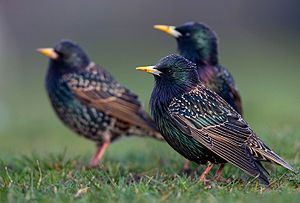
Starlings ( Sturnus vulgaris ) in splendor |
||||||||||||
| Systematics | ||||||||||||
|
||||||||||||
| Scientific name | ||||||||||||
| Sturnus vulgaris | ||||||||||||
| Linnaeus , 1758 |
The Star ( Sturnus vulgaris ), also called Common Star referred is that in Eurasia most widespread and common representative of the family of Stare (Sturnidae). Thanks to numerous naturalizations on other continents, the star is now one of the most common birds in the world. In Low German Stare are Spreen called.
The star was " Bird of the Year 2018" in Germany .
Appearance
With a body length of 19 to 22 cm, the star is slightly smaller than the blackbird . The tail is significantly shorter compared to the blackbird. The wings appear triangular and pointed when in flight. Male starlings of the nominotypical taxon weigh on average 81 g, females are slightly lighter with an average of 76 g.
In the plain dress , the body feathers are blackish with a metallic green or purple sheen and have white to beige tips. The whole body appears brightly dotted. The wings and control feathers are black-brown with light brownish hems, the arm wings are also broadly lined with a metallic sheen. The splendid dress is created in the spring by the wear of the bright, pointed spots on the body's plumage, and the body is then blackish and shiny metallic. The beak is yellow in the splendid dress, blackish in the plain dress. The legs are red-brown, the irises of the eyes are dark brown.
The sexes differ only slightly, females are a little less intensely colored with a metallic sheen than males, and the dot markings on the body are usually more clearly preserved in females in their magnificent dress. The base of the lower beak is blue-gray in males in splendid plumage and whitish in females.
Freshly flown starlings lack the metallic sheen, the body is earth-brown, only the throat is lightened whitish. The wings and control springs are dark brown without a metallic sheen. The beak is dull brown, the legs dark gray-brown.
Vocalizations
The singing is all year mostly from an exposed waiting argued during the breeding season usually close to the nest cavity. Intense singing starlings raise their plumage and flap their spread wings. The star is famous for his "mockery", that is, for his ability to imitate animal voices and sounds. The persistent, gossiping singing consists of a multitude of rising or falling whistling tones, clicking, hissing and guessing sounds as well as imitations of bird and other animal voices or technical noises. Quail , buzzard or lapwing , for example, are often imitated, as well as barking dogs, the sound of lawnmowers and, more recently, ring tones from cell phones . The warning calls differ depending on the threat. A quick, sharp, very short “spett, spett” is used to warn against flying enemies (crows, birds of prey, etc.), and for ground enemies with a repeated, drawn out “brrrrrrrt” or “tschrrr”.
distribution
The star colonizes the boreal and temperate zones as well as the northern edge of the Mediterranean zone of Europe and Asia from Iceland and Norway to central Siberia to around Lake Baikal . In northern Europe, the limit of distribution is on the North Cape and the Kola Peninsula, further east on the northern Urals , in western Siberia it recedes to about 60 ° north. The southern border of the distribution runs in Europe through northern Spain , southern France , Italy , former Yugoslavia and northern Greece ; in Asia through Turkey , northern Iraq and Iran , Afghanistan , Pakistan and north-west India to north-west Mongolia . The star was also naturalized in Southwest Africa, New Zealand , Australia and North America. In the latter, it now inhabits almost the entire continent from arctic Canada to subtropical Mexico .
The star is widespread across Europe, it is only absent in the interior of large closed forest areas, in completely cleared agricultural landscapes and at altitudes above about 1500 meters. Cities are also populated right down to the center. Highest densities are reached in areas with cave-rich groups of trees and neighboring grassland for foraging.
Yellow: breeding area in summer; blue: winter quarters; green: all year round.
Systematics
The subspecies of the star is controversial, the delimitation of the subspecies is mainly based on small differences in size and the color of the metallic sheen of individual plumage parts. The subspecies can hardly be distinguished in the field. The following illustration with 11 subspecies is based on Haffer (in Glutz von Blotzheim et al. 1993). The transitions between the individual subspecies are mostly fluid ( clinical ), so the distribution described must be understood as a rough approximation, especially for the Asian region.
- S. v. vulgaris Linnaeus , 1758: The nominotypical taxon colonizes almost all of Europe up to the southern limit of distribution ( see above ) and in the east to the Urals .
- S. v. faroensis Feilden , 1872: Isolated population on the Faroe Islands ; somewhat larger and stronger than nominate form.
- S. v. zetlandicus Hartert, E , 1918: Isolated population on the Shetland Islands and the Outer Hebrides ; Dimensions between nominate form and S. v. faroensis .
- S. v. poltaratskyi Finsch , 1878: East of the nominate form followed by western and central Siberia; in contrast to the nominate form, the head and throat are shiny purple.
- S. v. tauricus Buturlin , 1904: Two separate sub-areas in the south of the Ukraine and in the Crimea as well as in Turkey ; Blue-violet top, bronze-colored flanks.
- S. v. purpurascens Gould , 1868: east bank of the Black Sea , Armenia to northeast Turkey ; Head and throat shiny copper-red.
- S. v. caucasicus Lorenz , 1887: north of the Caucasus to the mouth of the Volga , then west and south of the Caspian Sea south to the Zagros Mountains in south-west Iran ; The margins of the upper elytra and the arm wings are purple.
- S. v. nobilior Hume , 1879: East of the Caspian Sea to Afghanistan ; Skull more purple and less shiny green than in S. v. caucasicus .
- S. v. porphyronotus Sharpe , 1888: Mountains and lowlands of Central Asia, to the east as far as the Tarim Basin and the Pamir ; Green, shining head sharply demarcated from purple body.
- S. v. humii Brooks, WE , 1876: West of the Himalayas ; Head shiny blue.
- S. v. minor Hume , 1873: lowlands in northwest India ; significantly smaller than any other subspecies.
The Handbook of the Birds of the World also recognizes the following subspecies:
- S. v. granti Hartert, E , 1903.
- S. v. oppenheimi Neumann , 1915
In the south of Europe and in North Africa the star is represented by the very similar monochrome star , both species are now combined into a super species .
Reproduction
The star builds its nest in a slightly unstructured manner from dry leaves, stalks, roots, straw, hair, wool and feathers in all kinds of caves. Mostly tree hollows, but also crevices in the rock and in the settlement area nest boxes and cavities in buildings of all kinds are accepted as breeding grounds.
Starlings bring about a brood marriage. Males can be monogamous during a breeding period , but the simultaneous mating with several females (simultaneous polygyny ) or successive broods with different females (successive polygyny) are also common. In a study in Belgium , 20–60% of all males were polygynous, in Frankfurt am Main at least 50%. In extreme cases near Frankfurt am Main, five broods with four different females were detected in one male in one breeding period; near Antwerp, a male brooded with two females at the same time and with three others successively. True second broods , on the other hand, are rare, their proportion probably rarely exceeding 10%. In Central Europe, the first broods are usually highly synchronized between April 10th and April 30th. The eggs are light green to light blue and without markings, they weigh on average 6.6 g and measure on average 31 × 21 mm. The clutch , which consists of 4 to 8 eggs, is incubated for 11–13 days. The nestling period is 17-21 days. In Central Europe, most of the young birds fly out between May 20th and June 10th. The last young birds from late broods and from subsequent broods of polygynous males fly out in mid to late July.
Age
Starlings can reach an age of more than 20 years in individual cases, as shown by ring finds: A star ringed in Denmark reached an age of 22 years and 11 months, a star ringed in Germany was 21 years and four months old.
food
The star is generally omnivorous, but the diet is very different from year to year. In spring and early summer, bottom-living invertebrates are mainly used, especially insects, but also earthworms and small snails. In the rest of the year, the star mainly eats fruit and berries of all kinds, in Central Europe mainly cherries and apples, in Western and Southern Europe mainly grapes and olives. In addition, the star also uses human food waste in settlements and on garbage dumps.
hikes
The star is in Europe according to geographical location sedentary to middle-distance migrants that Zugneigung increases to the east and north west. In Great Britain and Ireland the star is predominantly a resident bird. In Belgium , 50–70% of breeding birds stay in the country, in the Netherlands around 20%, around 80% overwinter in England , Belgium and Northern France at a distance of up to around 500 km from the place of birth. The Central European populations are partial migrants , the proportion of resident birds is 2.5% ( Switzerland and parts of southern Germany) to 8% (eastern Germany, the Czech Republic , Slovakia ). The north of Scandinavia , Finland , Eastern Poland , Russia , the north of Ukraine and Siberia will be almost completely abandoned in autumn .
The mean distances between the breeding area and the winter quarters for the Central and Eastern European populations are 1,000 to 2,000 km. The majority of European starlings overwinter in the Mediterranean region and in Northwest Africa as well as in Atlantic Western Europe.
From mid-June to early August, especially the young birds of the northeast populations make a so-called intermediate migration; the direction of migration is usually already in the direction of the winter quarters. The train is interrupted by the full moult . The actual migration begins at the beginning of September, it reaches its peak in mid-October and is largely complete at the end of November. The migration home begins in February and ends in Central Europe mostly at the end of March, in Northern Europe at the beginning of May.
behavior
Social behavior
Starlings move all year round in flocks and z. T. huge swarms. The star is only territorial at the breeding site, usually a small radius of up to 10 m around the breeding cave is defended. Food areas are not defended, but shared. Non-breeders also live in flocks during the breeding season. The young birds, which are independent from the middle of June, immediately form swarms that are concentrated in areas rich in food, these swarms become larger and larger due to the interim migration of the young birds from northeastern populations (see migrations) with a maximum in July. At night, shared beds are used, these beds are mainly in larger reed areas, but also in groups of trees and dense shrubbery, often in city centers. From June to the end of October there is a sleeping place for up to 40,000 starlings at the Berlin Cathedral . In winter quarters, these sleeping communities can contain more than 1 million individuals. The starlings gather at pre-assembly areas, mostly on exposed structures such as tall trees or power lines. From there they fly in groups or larger swarms to the actual sleeping place. Smaller groups usually fly low to the sleeping area. Large swarms with several thousand individuals often form a cloud over the roost, from which the starlings then fly downward in a tubular shape; at a greater distance the appearance resembles a tornado .
Enemy behavior
The strong synchronization of the breeding process, the immediate formation of swarms of the independent young birds and the year-round way of life in flocks, including the use of shared sleeping places, are used to a large extent to avoid enemies. Although the huge swarms attract predators, the risk of predation for the individual star in large numbers is low. The completely synchronized movements of large swarms when approaching a flight enemy (in Central Europe especially peregrine falcon , tree falcon , hawk and sparrowhawk ) are spectacular . Similar to a school of fish, the shoals jerk to an almost spherical shape, pulsate or form waves. These maneuvers are essentially intended to make it impossible for the attacking bird of prey to select a single bird.
Foraging
Foraging is mainly done on the ground by reading invertebrates of all kinds and hoes in soft soil. In contrast to the blackbird , the star moves on the ground striding and not hopping. Often the foraging for food takes place in close contact with grazing mammals, which are also often used as sitting guards. In addition, the star looks for food in higher vegetation, reads caterpillars and other invertebrates or chops at fruits. Flying insects are hunted from a control room, and in the case of mass occurrences they are also preyed on prolonged flight.
Inventory development
In Europe, the population of the star has increased strongly since the middle of the 19th century at the latest, in the course of this increase the species has expanded its area to the west and northeast. This population increase lasted until about the middle of the 20th century. The main reasons for this development are considered to be a milder climate, the strong increase in grassland due to the cultivation and drainage of the large moors, the expansion of fruit, wine and olive crops and the improved nutrient supply of the soil through fertilization. These factors led to an improvement in the food situation both in the breeding area and in the wintering area.
Since around the mid-1960s, strong population declines have been recorded in north-western and northern Europe, some of which can be attributed to the decline in pastureland and intensive use of pesticides, but also due to climatic factors.
In the Red List of Germany's breeding birds from 2015, the species is listed in Category 3 as endangered, as is the case in the federal states of Lower Saxony and Bremen.
There are only rough estimates for the star of the population. The British population was estimated to be at least 1.1 million breeding pairs (BP) at the end of the 1980s, 750,000–1.3 million BP were given for the Netherlands for 1979–1985, and 2.3–2.8 for Germany in 2008 Million BP and for Poland 1977 approx. 4 million BP. For Europe excluding Russia , the stock was estimated at 20–23 million BP in the early 1990s.
In North America, naturalization 1890/91 was carried out by release of about 100 starlings by Eugene Schieffelin in Central Park of New York . The population increased exponentially , in 1940 the population in all of North America was already estimated at 50 million individuals, in the early 1980s at 200 million. Due to the strong population increase and observed negative influences on the native species, the star in North America is called an invasive species . The world population was around 600 million individuals in the early 1980s. The star is one of the most common bird species in the world.
Relationship to people
Damage and control
The swarms of starlings, some of which comprise more than 1 million individuals, have caused considerable damage from eating, especially in wine-growing areas, but also in cherry orchards and olive groves, and in some cases the large sleeping places were perceived as a nuisance due to the noise and the amount of excrement. In particular, between 1950 and 1980, massive control campaigns were carried out in Western Europe and North Africa, in which several million starlings were killed with contact and nerve poisons or dynamite . These actions had no recognizable effects on the population and thus on the damage caused.
Various attempts to scare away the starlings with noise, blank shots, flashing rags and the like were just as unsuccessful. Today, high-quality wine cultures and cherry plantations are spanned over a large area with nets, and in some cases, attractive meadow areas are created near such cultures as an alternative food supply.
Keeping and use
Up until the 19th century, the star in Central Europe was kept free as a pet in the home by poor families , so many of his behavior were well known. Like almost all songbirds, it was eaten back then. In the early modern period, its meat was considered to be the most digestible or “lightest” bird meat.
Extract from a lexicon entry from the early 19th century:
If you take the young out of the nest and if an aria whistles to them, they learn it much more purely and whistle harder than Gimpel u. Linnets . In the talent to learn to speak, he even surpasses the magpie . However, he easily forgets what he has learned, [...] especially during the moult. He lives in the room with other birds sociable, gets used to the other domestic animals too, so that he cleans their backs of vermin [,] etc. is very cute. [...] He always wants to bathe. [...] The young St. is good food, but the old one tastes bitter and bitter. is difficult to digest. But it is often eaten, trying to take away its bitter taste by peeling off the skin.
The docility of a star already plays a role in Celtic mythology in the story of Branwen , part of the Mabinogion . The trapped Branwen trains a star to deliver a message, what he does and so her release.
Others
The star's ability to imitate voices sparked a copyright dispute between the publishing house Kiepenheuer & Witsch and the Berlin concept artist Wolfgang Müller , who was the first to publish a CD with star singing on which, in Müller's opinion, Kurt Schwitters' “ Ursonate ” is recited.
The German Nature Conservation Association and the State Association for Bird Protection in Bavaria have chosen the star as " Bird of the Year 2018" in Germany.
literature
- Urs N. Glutz von Blotzheim , Kurt M. Bauer, Einhard Bezzel: Handbook of the birds of Central Europe . Passeriformes (4th part): Corvidae – Sturnidae. tape 13-III . Aula-Verlag, Wiesbaden 1993, ISBN 3-89104-542-5 .
Web links
- The star up close and in a swarm.
- Singing star at www.vogelstimmen-wehr.de
- The star as a voice imitator
- Protection against harmful birds in viticulture ( page no longer available )
- Sturnus vulgaris in the endangered Red List species the IUCN 2008. Posted by: BirdLife International, 2008. Accessed October 13 of 2008.
- Age and gender characteristics (PDF; 5.4 MB) by Javier Blasco-Zumeta and Gerd-Michael Heinze (English)
- Feathers of the star
- Videos, photos and sound recordings of Sturnus vulgaris in the Internet Bird Collection
Individual evidence
- ↑ a b Imitation talent and formation artist. The star is "Bird of the Year 2018". NABU - Naturschutzbund Deutschland e. V., accessed on October 14, 2017 .
- ↑ K. Hüppop, O. Hüppop: Atlas for bird ringing on Helgoland. In: Vogelwarte. 47 (2009), p. 215.
- ↑ Christoph Grüneberg, Hans-Günther Bauer, Heiko Haupt, Ommo Hüppop, Torsten Ryslavy, Peter Südbeck: Red List of Germany's Breeding Birds , 5 version . In: German Council for Bird Protection (Hrsg.): Reports on bird protection . tape 52 , November 30, 2015.
- ↑ Thorsten Krüger, Markus Nipkow: Red List of Endangered Breeding Birds in Lower Saxony and Bremen, 8th version, as of 2015 . Ed .: Lower Saxony State Agency for Water Management, Coastal Protection and Nature Conservation. tape 35 , no. 4 . Hanover April 2015, p. 195 .
- ↑ cf. C. Sudfeldt, R. Dröschmeister, C. Grüneberg, S. Jaehne, A. Mitschke, J. Wahl: Birds in Germany - 2008. DDA, BfN, LAG VSW, Münster 2008, p. 7. Full text, PDF
- ↑ National Invasive Species Information Center of the United States Department of Agriculture, website
- ↑ Gerhard Eis : The Groß-Schützener health theory. Studies on the history of German culture in the southeast. Brno / Munich / Vienna 1943 (= Southeast European works , 36), pp. 44 and 95.
- ↑ Staar. In: Das Hauslexikon . Complete handbook of practical life creeds for all classes. Volume VII, Breitkopf and Härtel, Leipzig 1837, p. 621.
- ^ Report on the dispute at telepolis


